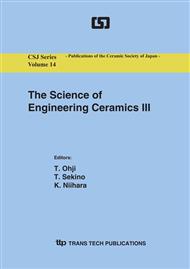p.713
p.717
p.723
p.729
p.733
p.739
p.743
p.747
p.751
Fabrication of Large Ceramic Components with Controlled Microstructure by Powder Thermoset Molding
Abstract:
Thermoset molding in wet and dry state was successfully employed to fabricate high strength reaction bonded silicon carbide (RBSC) ceramics. Granule transfer molding (GCM) was developed to prevent segregation of component particles and binder phase in wet state, while granule compression molding was applied in dry state to fabricate green compact with significant variation of compaction ratio. Low-fill density granules with mixing homogeneity were critical for promoting lateral deformation of granules during consolidation. In addition, anodic performance of Ni-YSZ anode was significantly enhanced by replacing solid fugitive phase with viscoelastic fugitive phase used as binder in thermoset molding.
Info:
Periodical:
Pages:
733-738
Citation:
Online since:
August 2006
Authors:
Price:
Сopyright:
© 2006 Trans Tech Publications Ltd. All Rights Reserved
Share:
Citation:


